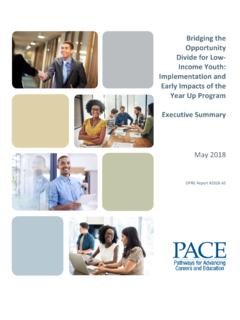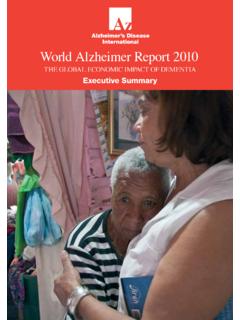Transcription of EXECUTIVE SUMMARY IS THE NINE BOX GRID ALL …
1 EXECUTIVE Yarnall and Dan LucyEmployee experiences of the nine Box GridIS THE nine BOX GRID ALL ABOUTBEING IN THE TOP RIGHT?2 Roffey Park Institute 2015 EXECUTIVE SUMMARYE xecutive SummaryThe nine Box Grid is now a widely used tool for identifying talent within an organisation, particularly in large organisations. The tool is used to assign employees to a box based on two dimensions; their current performance and their future potential. Typically the horizontal axis has three levels of performance and the vertical axis has three levels of potential.
2 Managers make a judgement on where each employee is placed. Organisations often attribute different labels to each box, beyond the obvious high potential/high performance . Despite its widespread use by the HR community, anecdotally we have heard HR practitioners express frustration with the nine Box. We also have heard quite diverse views about people s experience of using the tool. Much of the research on the grid tends to look from the outside in on the process. This research report takes a different view, looking from the inside out , exploring the experiences of employees using the grid to rate others and/or of being rated on the grid themselves.
3 Driving our research were a number of questions: What is the impact of using the grid on employee engagement and motivation? How helpful is the grid in driving and supporting a culture of development? What is the experience of managers using the grid to rate employees?The stated aims of the nine Box Grid are usually threefold:1. To provide a more robust assessment of an organisations talent and bench strength to aid future resource planning2. To aid diagnosis of training and development needs, and provide greater focus to development efforts3.
4 To aid discussions on careers, help set expectations for development and to motivate and engage talent within the research report offers some interesting insights in relation to each of these stated aims from a line manager and employee perspective rather than a corporate standpoint. PERFORMANCEP O TE N TIA LHigh potentialLow performanceHigh potentialMedium performanceHigh potentialHigh performanceMedium potentialHigh performanceLow potentialHigh performanceMedium potentialMedium performanceLow potentialMedium performanceMedium potentialLow performanceLow potentialLow performanceEXECUTIVE SUMMARY Roffey Park Institute 20153 What is the impact of using the grid on employee engagement and motivation?
5 We started out this research seeking to explore the impact of using the nine Box Grid on employee engagement and motivation. Our results suggest that from the perspective of the ratee, the grid process is failing to engage a high percentage of employees. For people rated in the five boxes with low performance or low potential, the experience is unsurprisingly demotivating as well as being seen as confusing and pointless. This begs the question of what organisations are really achieving by insisting on holding such conversations, or even formalising ratings for this group of employees.
6 Whilst the majority of the high performing, high potential employees are motivated by the experience, this is by no means unanimous, with one-third feeling the process didn t change anything and one in ten feeling less positive about their future career in the organisation. This was often a result of a lack of follow-on development more worrying is the nearly two-fifths of employees with some potential who are switched off by the nine Box, feeling less positive about their career prospects in the organisation and possibly demotivated as a result.
7 Movement from a higher rated box in one year to a lower rated box in the following year was particularly upsetting for employees and without exception reduced their engagement levels. Even where respondents are more positive about the rating experience, their commentary suggests that any motivational benefits are short-lived, particularly where there is a lack of follow up or developmental action shortly after the rating experience. The motivational benefits were primarily described as being about validating subjective perceptions of performance, giving some people a temporary feel-good was surprisingly common to hear that employees had not been informed about their rating or were not aware of whether they had been rated or not (one in three had not been informed, and one in five didn t know if they had been rated or not).
8 This, unsurprisingly, led to a sense of anxiety about conversations happening behind closed doors and of fates being determined without the opportunity to have one s say. This clearly had the potential to helpful is the grid in driving and supporting a culture of development?Our research indicated that the conversation the employee has with their manager is the vital part of the process and the grid is just a vehicle for that conversation to take place. Where managers are seen as having good people skills and engender a culture of feedback in their teams, then the grid process becomes an almost unnecessary prompt to enable this conversation to take place.
9 Where this is not the case, there is little evidence to suggest that the grid is helpful in driving different conversations to take place without support being put in place to develop the capability of managers to hold effective, and often difficult, conversations. Despite having nine boxes, the over-arching aim came across in the commentary as deciding on who should be placed in the top right hand box and ensuring that career progression and development opportunities were carefully managed at a cross-organisational level for this group.
10 Where this process was managed well, it was seen by many as benefiting the organisation in enhancing its bench strength. However, beyond this top right box, the focus for development was more frequently left to the immediate manager to determine and there were few examples of managers taking a different approach to their existing style. What is the experience of managers using the grid to rate others?Overall, nearly two-thirds (60 per cent) of managers found it easy to assign a box rating to individuals. That said, there was a clear difference between those in and outside the HR community.







